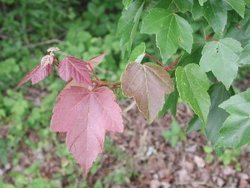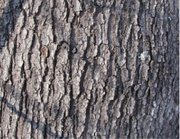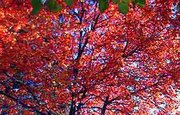Red Maple
|
|
| Red Maple | ||||||||||||||
|---|---|---|---|---|---|---|---|---|---|---|---|---|---|---|
 New spring growth on Red Maple Nesmith, South Carolina | ||||||||||||||
| Scientific classification | ||||||||||||||
|
Red Maple (Acer rubrum) is also known as Swamp Maple or Soft Maple. It is one of the most common and widespread deciduous trees of eastern North America, ranging from Lake of the Woods on the Ontario/Minnesota border, east to Newfoundland, south to near Miami, Florida, and southwest to east Texas.
Red Maple is adaptable to a wide range of site conditions and can be found growing in both swamps and on poor dry soil and anywhere in between; however it is often out-competed by Sugar Maple (Acer saccharum) on mesic sites. Chlorosis can be troublesome on neutral or alkaline soils. Red Maple is a medium-sized tree, reaching heights of 20-25 m (exceptionally to 40 m) and a diameter of 1 m, and can live for 100-200 years, rarely longer.
The leaves of the Red Maple are the easiest way to distinguish it from other maples. Like other American maples, they are deciduous and arranged oppositely on the twig. The leaves of Red Maples are typically 5-10 cm long and equally wide with 3-5 irregularly toothed lobes (in contrast, the leaves of the closely related Silver Maple Acer saccharinum are much more deeply notched and characteristically have 5 lobes). The upper side of the leaf is light green and the underside is whitish. The leaf stalks are usually red, as are the twigs. The leaves turn a brilliant red in autumn.
The twigs of the Red Maple are red to greyish-brown and hairless. Dwarf shoots are present on many branches. In winter, the twigs bear clusters of flower buds, easily seen from a distance. The twigs of Red Maple are almost impossible to distinguish from those of Silver Maple, except that the latter have an unpleasant odour when bruised.

The flowers are single-sex, with male and female flowers in separate clusters, though usually on the same tree. The female (seed), flowers are red with 5 very small petals and sepals borne in clusters, usually at the twig tips. The male (pollen) flowers are nothing more than yellow stamens protruding from dwarf shoots on the branches. Both types of flowers are found on the same tree, but young trees may only produce one type. Flowering starts early in the year after 1-30 growing degree days.
Maplekeys.jpg
The fruit is a samara, variable in color from red to brown to yellow. The samaras are 15-25 mm long and borne in pairs at an angle of 50-60 degrees. They mature in late May or early June.
Red Maple frequently hybridizes with Silver Maple; the hybrid, known as Freeman's Maple Acer x freemanii, is intermediate between the parents.
Cultivation and uses
Red Maple is widely grown as an ornamental tree in parks and large gardens. Numerous cultivars have been selected, often for intensity of fall color, with 'October Glory' and 'Red Sunset' among the most popular. Toward its southern limit, 'Florida Flame' is preferred. Many cultivars of Freeman's Maple are also grown widely.
The sap of the Red Maple can be used to produce maple syrup or sugar, but it is less sweet than that of the Sugar Maple.
Red Maple is the State Tree of Rhode Island.


